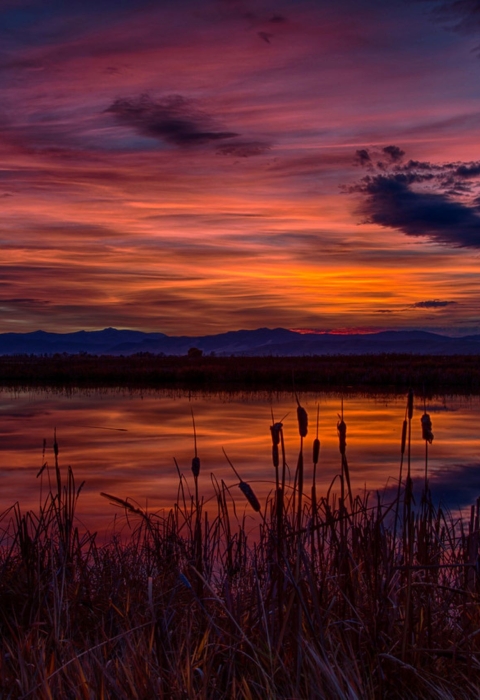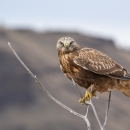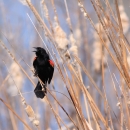Seasons of Wildlife
Winter - December, January, February
Winter can bring blowing snow and bone chilling cold. However, the short days and cold weather make many animals active throughout the day.
Late January through February can be a good time of year to see eagles in the area. It’s that time of year when the local cattle are calving and the eagles (both bald and golden, adult and immature) are waiting nearby for a meal. No, not of a newborn cow, but of the afterbirth (placenta) left behind.
Spring - March, April, May
Spring is the time for variety and abundance, with summer birds arriving to set up nesting areas and migrating birds traveling through on their way to northern lands. Local ducks, geese, water birds, osprey and songbirds are all active with courtship rituals, building nests, and laying eggs.
Parts of the Refuge close for protection of nesting birds. Check the access map in the Public Use Brochure.
Summer - June, July, August
Bird activity can pick up this time of year as young are leaving nests, learning to fly, and foraging. Red winged blackbirds and swallows begin to flock together by summer’s ends. And the early migrants from the north, particularly shorebirds like yellowlegs and plovers, start to move through. Water levels can become quite low, concentrating birds in the deeper areas and causing the closure of the fishing season for the public.
Fall - September, October, November
Young grebes, western, red-necked and pied-billed, follow their parents around, noisily begging to be fed. Waterfowl start to leave the area with more moving through from the north. A few birds migrate into the valley for the winter, including rough-legged hawks, seen soaring over the open uplands, hunting for small rodents.
Ninepipe National Wildlife Refuge closes to public access during hunting season to allow a resting area for the birds.
Featured Species
Waterfowl numbers vary through the year. The Mission Valley is located between the Pacific Flyway, found more to the west, and the Central Flyway, which is over the Continental Divide to the east. So Ninepipe National Wildlife Refuge rarely sees very large numbers of birds during migration. The birds seem to come in waves – such as a flock of 100 tundra swans for a few days before they move on, then the next week it might be the western grebes, then redheads, then coots, and so on.
Birds
The wetland habitat supports abundant waterfowl species such as mallards, northern shovelers, gadwalls, redheads and ruddy ducks. It has become an important breeding and staging area for a large portion of the Flathead Valley Canada goose population. Red-necked and western grebes nest on the refuge. American bitterns and sora rails can often be seen and heard. Non-breeding white pelicans spend the summer feeding and loafing. There is an active rookery of great–blue herons and another of double–crested cormorants.
Other birds include song sparrows, yellow–headed and red–winged blackbirds, and ring–necked pheasants. Osprey nest on platforms, which are located on the south shore of the refugee.
Ninepipe National Wildlife Audubon Christmas Bird Count
Ninepipe National Wildlife Refuge is the location for just one of over 2,300 National Audubon Christmas Bird Count circles. The Refuge sits in the center of a 15-mile diameter circle that encompasses a large portion of the Mission Valley, from Ronan to Charlo to St. Ignatius, east into the Mission Mountains and along McDonald Reservoir, northwest to the Lower Crow Reservoir, and southwest to include a corner of the National Bison Range. To find out about specific results for this count (coded as MTNI), or to learn about other circles and how to be involved, visit the National Audubon Christmas Bird Count website.
Animals
Since most of Ninepipe National Wildlife Refuge is composed of open water, resident animals include those dependent on, and able to live with, water. Common mammals include muskrat, striped skunk, mink, field mice, and meadow voles. A few white-tail deer will be seen on the uplands.
Grizzly bears will sometimes move down from the Mission Mountains to forage on sedges and grasses, and to hunt for rodents on Ninepipe National Wildlife Refuge and surrounding lands. The bears need to cross Highway 93 to reach this area and, unfortunately, one or two bears are killed each year. The Confederated Salish and Kootenai Tribes and the Montana Department of Transportation are working together to develop crossings, both under-highway passes and wildlife bridges, to reduce casualties, not only for bears, but other wildlife using the Refuge and surrounding areas. Many have already been installed along Highway 93 both north and south of the Refuge and are monitored to determine effectiveness. Designs for the Ninepipe area are in the works.


